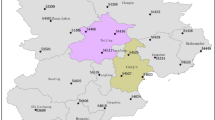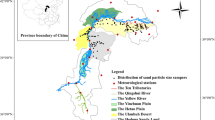Abstract
At present, the wind and snow loads are calculated independently when determining the design specifications for building structures. Yet, when snow drifting occurs, the basic wind and snow pressures exist almost simultaneously. Therefore, building specifications based on the independent calculations of the wind and snow loads cannot be used effectively in areas that are severely impacted by snow drifting. Some parts of the Xinjiang Uygur Autonomous Region of China have suffered particularly severe snow drifting natural disasters. In this paper, we offer an analysis of the statistical characteristics of the spatial distribution of wind and snow in this region. In particular, we extract the values of the combined distribution of the wind and snowfall in the Xinjiang Uygur Autonomous Region of China by using parameters such as snowfall intensity, snowfall amount, wind speed, and wind direction as indicators that show the snow drifting disasters. This study found that, after heavy snowfall events, the accumulative wind scale is high and the accumulative snowfall is large in the Altay, the Bortala Mongol Autonomous, and the Tacheng Prefectures of northern Xinjiang, and the Kizilsu Kirghiz Autonomous Prefecture of western Xinjiang. It has an important practical significance for the design of building structures and the treatment of snow drifting disasters.










Similar content being viewed by others
References
Chen H, Fan X (2009) Some extreme events of weather, climate and related phenomena in 2008. Clim Environ Res 14(3):329–340 ((in Chinese with English Abstract))
China Academy of Building Research (2012) Load code for the design of building structures. China Architecture & Building Press. GB 50009-2012
Flaga A, Flaga L (2019) Wind tunnel tests and analysis of snow load distribution on three different large size stadium roofs. Cold Reg Sci Technol 160:163–175
Hong HP, Tang Q, Yang SC, Cui XZ, Cannon AJ, Lounis Z, Irwin P (2021) Calibration of the design wind load and snow load considering the historical climate statistics and climate change effects. Struct Saf 93:102135
Li X, Zhu J, Jia Y, Liu J, Li N, Li F (2007) Formation process of extraordinarily serious snowstorm and its induced damage in 2007 in Liaoning Province. Chin J Ecol 8:1250–1258 (in Chinese with English Abstract)
Liu J, Yao X, Han Z, Xie P, Liu L, Liu P (2008) Analysis on the cause and type of wind blowing snow on highways in Xinjiang. Highway 1:25–27 (in Chinese)
Liu W, Liu X, Chen H (2010) On the successful shaping of local government image in Blizzard disaster: an example of Xinjiang Blizzard Disaster in 2010. J Inst Disaster Prev 12(2):119–136 (in Chinese with English Abstract)
National Meteorological Centre (2012) GB/T 28591-2012 wind scale. Standards Press of China, Beijing
National Meteorological Centre (2017) GB/T 21984-2017 short-range weather forecast. Standards Press of China, Beijing
Su G (2017) Research on numerical simulation of wind blowing snow at railway cut and disaster prevention and control engineering master, Lanzhou Jiaotong University. (in Chinese with English Abstract)
Wang T (2009) Study on numerical simulation and prevention measures of the drifting snow disaster along railway master, Lanzhou University. (in Chinese with English Abstract)
Wang Y, Rosowsky DV (2013) Characterization of joint wind–snow hazard for performance-based design. Struct Saf 43:21–27
Winstral A, Marks D, Gurney R (2013) Simulating wind-affected snow accumulations at catchment to basin scales. Adv Water Resour 55:64–79
Ying C (2007) Research on the countermeasures of the blowing snow hazards on highways doctor, Jilin University. (in Chinese with English Abstract)
Yu X, Zhang Y, Liu Q, Jia Y, Gao L, Bu J (2021) Statistical characteristics of the spatial distribution of wind and snowfall in the Beijing–Tianjin–Hebei region. Sci Rep 11(1):3500
Zha M, Yu Z, Li H (2012) Study on the prevention against snow hazard for the highway between Karamay and Tacheng. J China Foreign Highway 32(4):67–71 ((in Chinese))
Zhou X, Hu J, Gu M (2014) Wind tunnel test of snow loads on a stepped flat roof using different granular materials. Nat Hazards 74(3):1629–1648
Zuo H, Yan M, Wang H, Dong Z, Li G (2019) Assessment of snow drift impact in the northern Steppe region of China. CATENA 177:219–226
Acknowledgements
The research reported herein was sponsored by the National Natural Science Foundation of China (Grant No. 51778381), the Hebei Province Natural Science Fund (Grant No. D2016210008 and Grant No. E2018210044) and the Hebei Province Social Science Fund (Grant No. HB21GL010). We would like to thank TopEdit (www.topeditsci.com) for English language editing of this manuscript.
Author information
Authors and Affiliations
Corresponding authors
Ethics declarations
Competing interests
The authors declare no competing interests.
Additional information
Publisher's Note
Springer Nature remains neutral with regard to jurisdictional claims in published maps and institutional affiliations.
Appendices
Appendix A
See Table 4.
Appendix B
See Table 5.
Appendix C
See Table 6.
Appendix D
See Table 7.
Appendix E
See Table 8.
Appendix F
See Table 9.
Rights and permissions
About this article
Cite this article
Yu, X., Liu, M., Wang, J. et al. Statistical characteristics of the spatial distribution of wind and snow in the Xinjiang Uygur Autonomous Region. Nat Hazards 111, 1977–2009 (2022). https://doi.org/10.1007/s11069-021-05127-4
Received:
Accepted:
Published:
Issue Date:
DOI: https://doi.org/10.1007/s11069-021-05127-4




